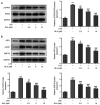Glaucocalyxin A alleviates lipopolysaccharide-induced inflammation and apoptosis in pulmonary microvascular endothelial cells and permeability injury by inhibiting STAT3 signaling
- PMID: 35369532
- PMCID: PMC8943557
- DOI: 10.3892/etm.2022.11242
Glaucocalyxin A alleviates lipopolysaccharide-induced inflammation and apoptosis in pulmonary microvascular endothelial cells and permeability injury by inhibiting STAT3 signaling
Abstract
Glaucocalyxin A (GLA), an ent-kauranoid diterpene derived from Rabdosia japonica var. glaucocalyx, possesses antibacterial, anti-oxidative and anti-neuroinflammatory properties. The present study aimed to investigate the potential mechanisms underlying GLA in the pathogenesis of pneumonia. Human pulmonary microvascular endothelial cells (hPMVECs) treated with lipopolysaccharide (LPS) were treated with GLA, followed by the detection of cell viability, inflammation, apoptosis and cell permeability. Furthermore, the protein expression levels of apoptosis- and permeability-associated proteins were determined using western blot analysis. Following treatment with a signal transducer and activator of transcription 3 (STAT3) activator, the protein expression levels of STAT3 and endoplasmic reticulum stress-associated proteins were determined, to confirm whether STAT3 signaling was mediated by GLA. Lastly, the mRNA expression level of inflammatory cytokines, apoptosis and permeability injury were also determined following treatment with a STAT3 activator. The results revealed that GLA ameliorated inflammation, apoptosis and permeability injury in LPS-induced hPMVECs. Following treatment with a STAT3 activator, the therapeutic effects of GLA on LPS-induced hPMVECs were abrogated. In conclusion, GLA alleviated LPS-induced inflammation, apoptosis and permeability injury in hPMVECs by inhibiting STAT3 signaling, which highlighted the potential therapeutic value of GLA in the treatment of pneumonia.
Keywords: STAT3; apoptosis; glaucocalyxin A; inflammation.
Copyright: © Cao et al.
Conflict of interest statement
The authors declare that they have no competing interests.
Figures







Similar articles
-
Glaucocalyxin A suppresses multiple myeloma progression in vitro and in vivo through inhibiting the activation of STAT3 signaling pathway.Cancer Cell Int. 2021 Dec 19;21(1):683. doi: 10.1186/s12935-021-02375-z. Cancer Cell Int. 2021. PMID: 34923957 Free PMC article.
-
Glaucocalyxin A alleviates LPS-mediated septic shock and inflammation via inhibiting NLRP3 inflammasome activation.Int Immunopharmacol. 2020 Apr;81:106271. doi: 10.1016/j.intimp.2020.106271. Epub 2020 Feb 12. Int Immunopharmacol. 2020. PMID: 32062071
-
Glaucocalyxin A impairs tumor growth via amplification of the ATF4/CHOP/CHAC1 cascade in human oral squamous cell carcinoma.J Ethnopharmacol. 2022 May 23;290:115100. doi: 10.1016/j.jep.2022.115100. Epub 2022 Feb 10. J Ethnopharmacol. 2022. PMID: 35151835
-
Glaucocalyxin A-induced oxidative stress inhibits the activation of STAT3 signaling pathway and suppresses osteosarcoma progression in vitro and in vivo.Biochim Biophys Acta Mol Basis Dis. 2019 Jun 1;1865(6):1214-1225. doi: 10.1016/j.bbadis.2019.01.016. Epub 2019 Jan 16. Biochim Biophys Acta Mol Basis Dis. 2019. PMID: 30659925
-
Decoding cell death signals in liver inflammation.J Hepatol. 2013 Sep;59(3):583-94. doi: 10.1016/j.jhep.2013.03.033. Epub 2013 Apr 6. J Hepatol. 2013. PMID: 23567086 Review.
Cited by
-
DGA ameliorates severe acute pancreatitis through modulating macrophage pyroptosis.Inflamm Res. 2024 Oct;73(10):1803-1817. doi: 10.1007/s00011-024-01931-3. Epub 2024 Sep 5. Inflamm Res. 2024. PMID: 39231819
-
Quercetin attenuates inflammation in LPS-induced lung epithelial cells via the Nrf2 signaling pathway.Immun Inflamm Dis. 2024 Feb;12(2):e1185. doi: 10.1002/iid3.1185. Immun Inflamm Dis. 2024. PMID: 38353312 Free PMC article.
References
LinkOut - more resources
Full Text Sources
Research Materials
Miscellaneous
